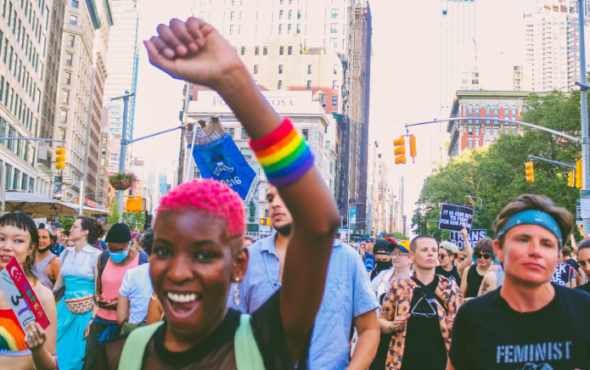
More than 1.5 million people identify as lesbian, gay, or bisexual, according to England and Wales’ first-ever sexuality and gender census.
Newly released census data shared by the Office for National Statistics (ONS) revealed that 3.2% of the population identify as lesbian, gay, bisexual or as another sexual identity that is not straight.
The census, which took place in England and Wales on 21 March 2021, offers a data-driven insight into of the population.
The ONS found that 748,000 participants described themselves as gay or lesbian (1.5%), while 624,000 (1.3%) identified as bisexual. 165,000 people said they are a sexuality not listed by the ONS, while 262,000 people (0.5%) said their gender identity was different to their sex registered at birth.
In comparison to the above, the census found that 89.4% of people said they were straight or heterosexual.
This 2021 census is the first time participants were asked about their sexual orientation and gender identity. The voluntary question was unanswered by 7.5% of the population.
The data also painted a clearer picture of the transgender and non-binary population across England and Wales. ONS data revealed that 262,000 people identify as a gender different to their sex registered at birth.
“For the past two centuries of data gathering through our national census, LGBTQ+ people have been invisible, with the stories of our communities, our diversity, and our lives missing from the national record,” said Nancy Kelley, the chief executive of Stonewall.
Kelley added that the new figures “finally paint an accurate picture of the diverse ‘Rainbow Britain’ that we now live in, where more and more of us are proud to be who we are”.
The ONS said the figures would “support anti-discrimination duties under the Equality Act 2010 and aid allocation for resources and policy development”.
The government previously estimated there to be between 200,000 and 500,000 transgender people in the UK, the BBC reports.
Dr Kevin Guyan, Research Fellow at the University of Glasgow and LGBT data expert, has called the collected data a “landmark moment for inclusion”.
Speaking to GAY TIMES, Guyan highlighted the significance of collating data: “A census shines a light on some parts of the LGBTQ+ community, but it also pushes some of the wider community further into the shadows and isn’t doing anything to capture those identity categories.”
Jayne Ozanne, a former LGBTQ+ government advisor commented on the newly released census data to The Metro. “I am both grateful and relieved that we finally have a more accurate understanding of the numbers of LGBTQ+ people in England and Wales thanks to the 2021 Census,” Ozanne said.
“This has finally broken the old adage ‘if you’re not counted, you don’t count’ – indeed there is now no excuse for ignoring the needs of some of our most marginalised members of society.
“I, therefore, hope that our government will take more seriously its responsibilities to the LGBTQ+ community, especially to over a quarter of a million trans and non-binary people who felt able to be open in the census survey.”
This is the first time that England and Wales have included LGBTQ+ people in its 220-year long-running collection of data.
Census figures from Scotland are expected to be published later this year. Similarly, responses to Northern Ireland’s question on sexual orientation will be shared this year. However, the Northern Ireland census did not include a question on gender identity.
You can now access data on sexual orientation and gender identity data by clicking through the link below.
Sexual orientation and gender identity data are now available from #Census2021.
These results come from responses to a first-time, voluntary question in the census, giving a unique insight into the population of England and Wales.
Learn more ➡️ https://t.co/e69k0MN0nd pic.twitter.com/5UWzOkh5jq
— Census 2021 – England & Wales (@Census2021) January 6, 2023



